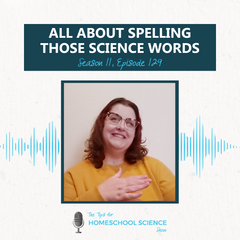FREE Shipping on all our products! (Please Note: Orders may experience a delay of a week or more in shipping due to the high volume of orders at this time of year.)
FREE Shipping on all our products! (Please Note: Orders may experience a delay of a week or more in shipping due to the high volume of orders at this time of year.)
What is nature study? {Episode 8}
July 11, 2016 2 min read
What is nature study? {Episode 8}
Where does nature study fit into teaching science at home? Is it the centerpiece? Or just an afterthought? Should it even be a part of your plan at all? In today’s episode of the Teaching Science at Home show, we are going to break down the concept of nature study into building blocks you can use in your home.
Or Listen to the Audio
Don't miss an episode - subscribe to the Teaching Science at Home Show through iTunes and Stitcher!
The Highlights
Nature study is a style of educating that searches for the principles of science in nature.
What is nature study?
In short, nature study awakens the scientific side of the brain in the same way that good book can awaken the imagination.
- It helps the student to see science face to face, to understand the processes going on around them every day and to develop in them a hunger to learn more.
- The study of science began with philosophers observing things in nature that made them question why.
Nature study can be one of the tools we use to train them how to observe because it teaches the student to slow down and really see the science surrounding them.
The Components of Nature Study
# 1 – The Nature Walk
Nature study begins with the nature walk.
- This is a time set aside to go out and explore the world around you.
- It can be a simple stroll or a planned hike.
- Think of it as a “walk with a purpose.“
- Take time to point out the focus of your nature study.
- Allow your student to ask any questions they have.
- Provide them with any important information that you would like for them to know.
#2 – The Nature Journal
The second component of your nature study is the nature journal.
- The nature journal should be a personal record of what the student has learned.
- In it they should feel free to glue in pictures or samples, draw what they have seen and record their thoughts.
- Students should record at least one scientific fact about the subject being studied and the date with each entry.
How do you add nature study to your homeschool science plan?
So, how can you add nature study to your current homeschool science plan? Here are two options:
- Option #1 - Take advantage of impromptu nature study opportunities.
- Option #2 - Include nature study in your "Friday Fun Day" plan.
Additional Resources
We have a series here called InstaScience that can help you as you plan out topics and prepare for a Friday nature study time.
Or you can check out our Nature Study Tips Pinterest Board:
Learn more about how you can teach science with our programs!
Also in {Podcast} The Tips for Homeschool Science Show
All About Spelling Those Science Words {Season 11, Episode 129}
March 25, 2024 7 min read

In this episode, we'll be interviewing Robin Williams from All About Spelling. Click "Read More" to listen is as we discuss tips and tricks for spelling all those science words!
How should you handle notebooking through the different ages? {Season 11, Episode 128}
March 18, 2024 3 min read

Writing in Science with a Well-Trained Mind (Interview) {Season 11, Episode 127}
March 11, 2024 16 min read

Click "Read More" to listen in as Susan Wise Bauer and Susanna Jarret join Paige to share tips and tools about the third key to teaching science!
Subscribe
Sign up to get the latest on sales, new releases and more …

